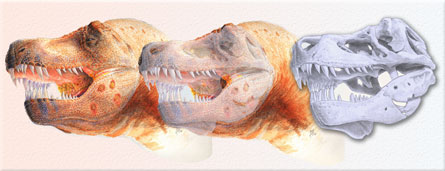The bug that may have killed a dinosaur
The holes in the jaw bone of a world-famous T. Rex suggest the dino died from a parasite infection
Share this:
- Share via email (Opens in new window) Email
- Click to share on Facebook (Opens in new window) Facebook
- Click to share on X (Opens in new window) X
- Click to share on Pinterest (Opens in new window) Pinterest
- Click to share on Reddit (Opens in new window) Reddit
- Share to Google Classroom (Opens in new window) Google Classroom
- Click to print (Opens in new window) Print
 |
|
The holes in a T.rex jaw were probably left by a parasite, the new work suggests.
|
| Renderings by Chris Glen, University of Queensland |
Sue is a famous Tyrannosaurus rex whose skeleton lives in the Field Museum in Chicago. Small, smooth holes in Sue’s jawbones have been a scientific mystery for years, and scientists want to know how they formed. Some researchers have believed, for example, that the holes resulted from a dino-on-dino fight.
Scientists may have solved the mystery in Sue’s jaws. A new study suggests that the holes were caused by something much smaller than another dinosaur. In the new study, researchers say the holes may have come from infection by a tiny parasite — and that infection may have killed the mighty dinosaur.
A parasite is an organism that cannot live on its own. Instead, it feeds and lives on another organism. In Sue’s case, the guilty parasite is called Trichomonas. Unlike the dinosaurs, which became extinct about 65 million years ago, different kinds Trichomonas still live on the Earth.
In the worst cases, a Trichomonas infection can cause tissues to swell and block the throat. It can also cause the jaw to rot — and leave holes in the bones. These symptoms would be bad news for a T. rex with a nasty Trichomonas infection. Unable to swallow food, the dinosaur would eventually die of thirst or starve.
“There are some things you can survive,” Ewan Wolff, one of the researchers, told Science News. “But not having a hole in the back of your throat is not one of them.”
Today, this parasite often infects such birds as pigeons, turkeys and chickens — and it was a bird that gave Wolff a clue. Wolff is a paleontologist at the University of Wisconsin–Madison. He says the shapes, sizes and locations of the holes in Sue’s jaw are different than what you would expect if the holes had been caused by a dino fight or by another kind of infection. So he and his colleagues started looking for another explanation, and they looked at the bones of modern birds and crocodiles that had various diseases.
The scientists caught a break with the skull of an osprey, a fish-eating hawk easily recognized by its dark back and white chest. The osprey had holes in its jaws similar to Sue’s, and the scientists knew that when the bird was alive it was infected with Trichomonas. They started looking at other T. rex skulls and found nine, including Sue’s, with the telltales holes of a Trichomonas infection.
“Either this was a fantastic coincidence, or this was a very common disease in T. rex,” Wolff told Science News about the match between the osprey and Sue.
Scientists aren’t sure how the T. rex caught the parasite. Perhaps it ate an infected animal. Wolff says the parasite may also have been spread from dino to dino through face-biting or cannibalism.
POWER WORDS (adapted from the Yahoo! Kids Dictionary)
parasite An organism that grows, feeds and is sheltered on or in a different organism while contributing nothing to the survival of its host
paleontologist A scientist who studies the forms of life that existed in prehistoric or geologic times, as represented by the fossils of plants, animals and other organisms
infection When a disease-causing microorganism invades and multiplies in a body part or tissue, possibly causing more tissue injury and serious disease.
extinct No longer existing or living, usually said of an entire species.







